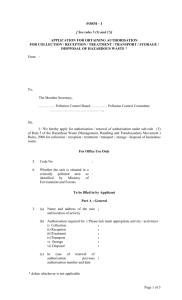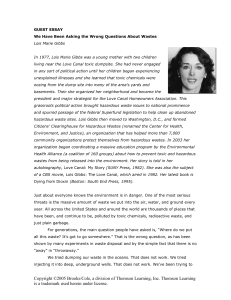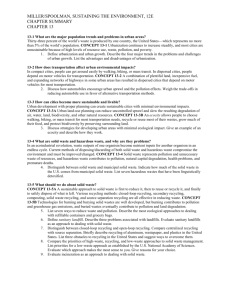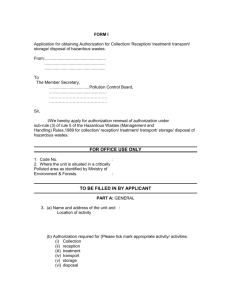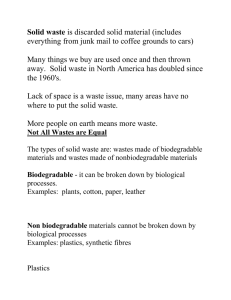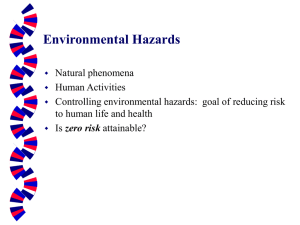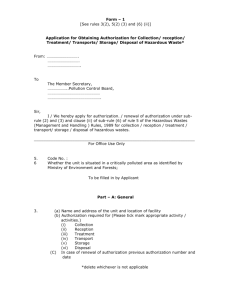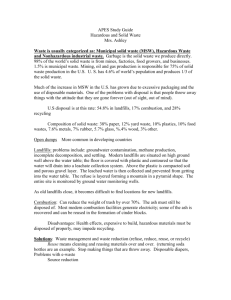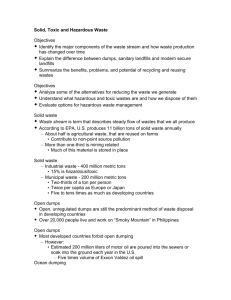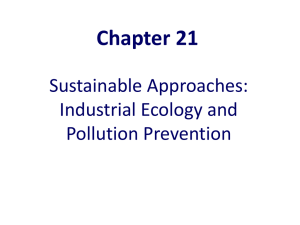Ch 21 Solid Waste
advertisement
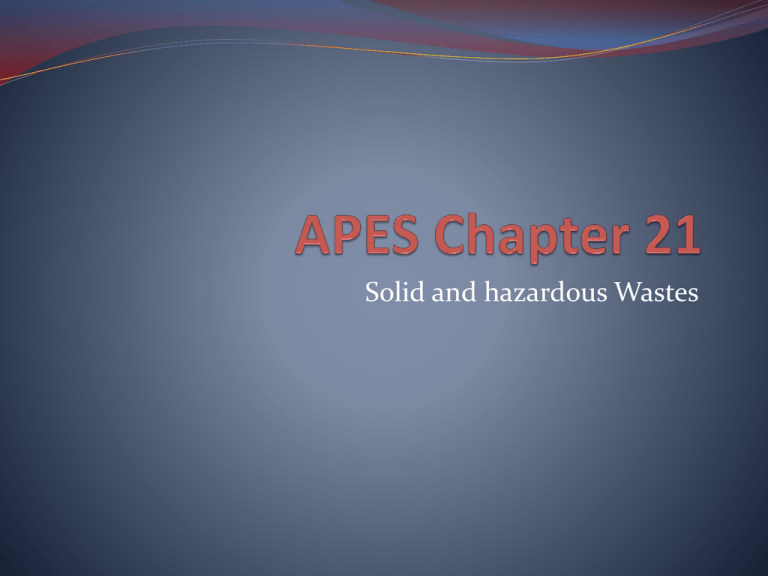
Solid and hazardous Wastes Wasting Resources: The high-waste approach 33% of solid waste is in the USA solid waste: Any unwanted material that is not liquid or gas, 98% of solid waste comes from mining and oil/natural gas production. Industrial Solid Waste includes: wasted scraps, sludge, fly ash, old machinery Remaining 1.5% is Municipal Solid Waste- from homes and businesses in urban areas Often the disposal of this waste goes unchecked What is hazardous waste, and how much is produced? Includes: 1) contains one or more of the 39 toxic, mutagenic, etc. compounds. 2) caustic. 3) flammable. 4) is reactive enough to explode or pollute the air with its fumes. Does not include: 1) Radioactive wastes 2) Hazardous wastes discarded by households 3) Mining wastes 4) Waste from small businesses and factories 5.5 billion metric tons of hazardous waste are disposed of each year 6% is legal hazardous waste 94% is unregulated waste Producing Less Waste What are the options? 2 ways: 1) High-waste approach - Burying, burning, or shipping hazardous waste to another country/county. 2) Low-waste approach - Views waste as a potential resource: Recycle, compost, or reuse. Also try to avoid contributing to the amount of hazardous waste Goals: 1) Reduce 2) Reuse 3) Recycle and compost 4) Incinerate 5) Bury Why is producing less waste and pollution the best choice? 1) Saves energy and virgin resources 2) Reduce environmental effects of extracting processing, and using resources 3) Improve worker health and safety 4) Decrease pollution control and waste management costs Reuse What are the advantages of refillable containers? Reuse Extends resource supplies Keeps high-quality matter resources from being reduced to low-quality matter waste Reduces energy use and pollution. Reuse of glass bottles has virtually gone away Some want the reinstatement of the system because of the money it saves Examples of reusable containers include lunchboxes and Tupperware Plastic containers degrade slowly. Paper bags use trees and pollute the air and water Recycling How can we recycle organic solid wastes? Community Composting Compost- dark-brown, humus-like material that is rich in organic matter and soil nutrients. produced when microorganisms break down organic matter 35% of municipal solid waste is biodegradable Two Types of Recycling Primary or secondary 1) Primary or closed-loop recycling - Wastes from consumers are recycled to create products of the same type. 2) Secondary or open-loop recycling - Waste material is converted into other products. Case Studies: Recycling Aluminum, wastepaper, and plastics How much aluminum is being recycled? Benefits of recycling aluminum as opposed to mining: 95% less air pollution 95% less energy used About 65% of aluminum cans are recycled in US How much wastepaper is recycled? Paper is one of the easiest materials to recycle In 1996 the US recycled 40% of its waste paper Benefits: Saves energy, reduces air pollution, water pollution, groundwater contamination, saves water, saves money. Is it possible to recycle plastics? Plastics industry is a leading producer of toxic waste Most plastics are nondegradable or take 200-400 years to degrade Environmentalists believe that many uses for plastics are unnecessary Detoxifying, burning, burying, and exporting wastes How can hazardous waste be detoxified? If waste can’t be reused and it is toxic, it must be converted into a less toxic form Denmark has the best toxic waste detoxification program in the world Bioremediation- using microorganisms to detoxify Phytoremediation- using plants to remove contaminants Burning solid and hazardous waste 15% of municipal solid waste, and 7% of hazardous waste was burned in 150 incinerators All incinerators burning hazardous waste pollute the air Land disposal of solid waste Sanitary landfill- 57% of solid waste benefits: cheap, easy, reduces air pollution drawbacks: groundwater pollution, and gases from anaerobic decomposition Land disposal of hazardous wastes Deep Well Disposal pumping waste into layers of rock below Problem: aquifers used for groundwater Surface Impoundment ponds and lagoons Problem: pollute groundwater and air Exporting waste Many countries are trying to ban the export of toxic waste Companies export waste because it is cheaper than proper disposal Cases Studies: lead, dioxins, and chlorine How can we reduce exposure to lead? High levels of lead blood causes lower IQ, hyperactivity, nervous system impairment, and other disorders. Sources: leaded gasoline, lead paint, etc. How dangerous are dioxins? Definition: a family of 75 chlorinated hydrocarbon compounds formed as unwanted by-products in chemical reactions involving chlorine and hydrocarbons. Can cause cancer Dioxine Poisoning What should we do about chlorine? Chlorine is used for plastics (manufacturing), solvents, and paper, pulp bleaching In so many cases, there are alternatives to chlorine use - but they are more expensive to use. Hazardous-waste Regulation What is the Resource Conservation and Recovery Act (RCRA)? Passed in 1976: Forces EPA to identify and manage disposal of toxic waste, helps states establish waste management programs. (Cradle to Grave) However, most producers of hazardous waste are able to get away with illegal dumping. What is the Superfund Act? 1980: Comprehensive Environmental Response, Compensation and Liability Act- Cleans up abandoned dumping sites. This act forces the polluter to pay in many cases The government still has to pay billions in disaster Solutions: Achieving a Low-waste society 1) Everything is connected 2) There is no “Away” 3) Dilution is NOT the solution

